Customer Satisfaction Metrics That Will Tell You The Truth

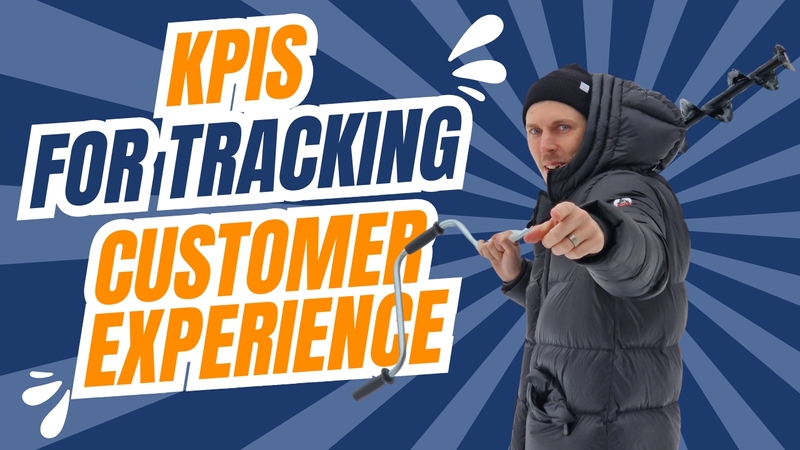
In my 15 years as an entrepreneur, I've learned that you can’t run a successful business without meeting your customers’ expectations. To know what your customers expect of you, you need to ask them face-to-face and with surveys.
Measuring customer satisfaction and customer experience is the key to success for all businesses across industries.
I've helped hundreds of companies measure customer experience for the first time, and the thought process is always the same:
- Business leaders are nervous, skeptical, and sometimes over-confident
- When customer feedback comes flying in, the owners are either super happy or embarrassed
- Customer sentiment is looked at closely
- Customer journey is re-evaluated based on the feedback
Next, I'll go over which KPIs companies should track regarding customer experience and how these numbers will help reduce customer churn and improve the customer retention rate.
Customer Experience Metrics in Short:
- Use Net Promoter Score surveys to measure overall customer loyalty
- Add Customer Effort Score CES to the end of chat interactions
- Use CSAT and star rating forms to measure short-term happiness
- Organic growth follows good customer experience
- Total revenue and sales increase when you have satisfied customers
KPIs in Customer Experience
Potential new customers want to know what others think about you. Your happy, loyal customers are your best salespeople.
It's impossible to create a successful business if existing customer aren't happy.
Think of it this way: If there's a hole at the bottom of your bucket, it's never going to be full, no matter how fast you pour water in it. The only way to get the bucket to stay full is to fix the hole.
The bucket is your customer journey, and the hole is a bad customer experience (CX). By having a great customer experience, you're influencing customer lifetime value (CLV) and lowering customer acquisition costs.
CX Metrics to Track
- Net Promoter Score
- Customer satisfaction
- Average resolution time
- Customer Effort Score CES
- Customer sentiment
- Customer referral rate
- Overall state of customer voice (open feedback, online reviews, discussion forums, support tickets, direct feedback, ...)
- Customer acquisition cost
- Churn rates
- Customer lifetime value
I know this sounds like a lot, but I'll hold your hand through setting up the processes, if needed!
All of these customer experience metrics are absolutely necessary to master.
Real-Life Example: Customer Insights at the Heart of Growth
The business owner of renovation company Hohdepinnoitus says:
– Without Trustmary, we would be missing the backbone for validating that we’re doing great work. It plays a surprisingly big role in our activities at the moment. I can say with all my heart that it is a good tool. We get immediate feedback on what we do. Whether it’s failures or successes, getting immediate feedback on everything allows us to react to it. It’s essential for improving our operations, says Eronen.
Read the full story of how Hohdepinnoitus grows by knowing its customers.
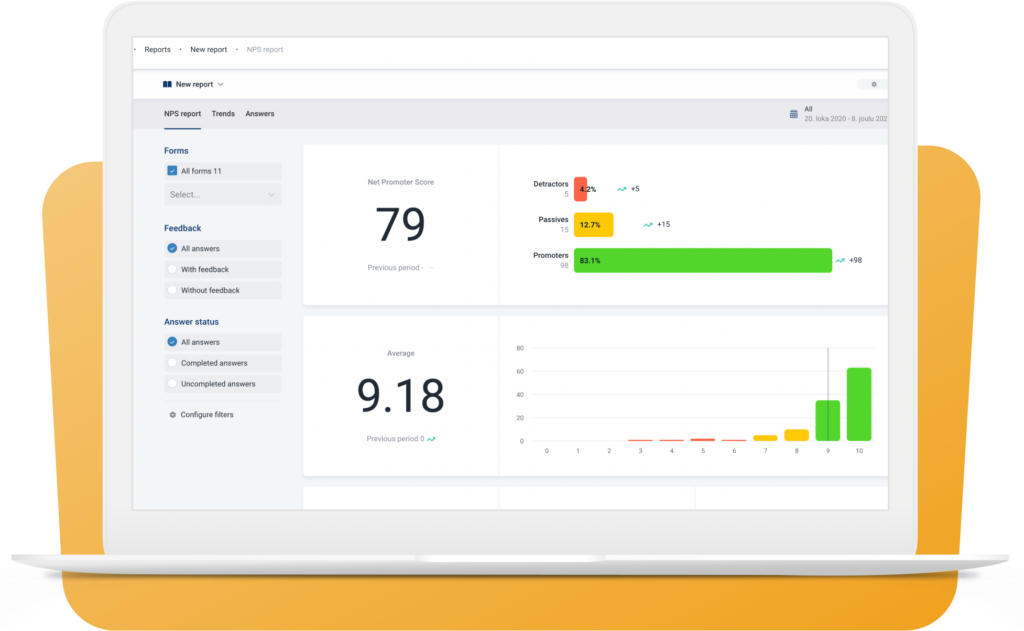
Case Example: More Sales with Social Proof
📍 Company: Pohjoisen Auto (three locations: Ranua, Rovaniemi, Oulu)
📍 Industry: Selling used cars and small machines, maintenance services
📍 Challenge: No customer feedback and doubts if customers would give it
📍 Solution: Uses Trustmary to collect reviews and put them on the website.
📍 Results: Response rate close to 100%, hundreds of reviews on the website
Thanks to measuring it's customer experience and adding testimonials and reviews from happy customers to its website, Pohjoisen auto got more sales in January than ever before.
– We have had our best January ever in terms of sales. The industry in general is not doing so well, but our business is booming. We have a really positive feeling internally now, thanks to the feedback from our customers, which also influences our sales, says CEO Ville Hanhisuanto.
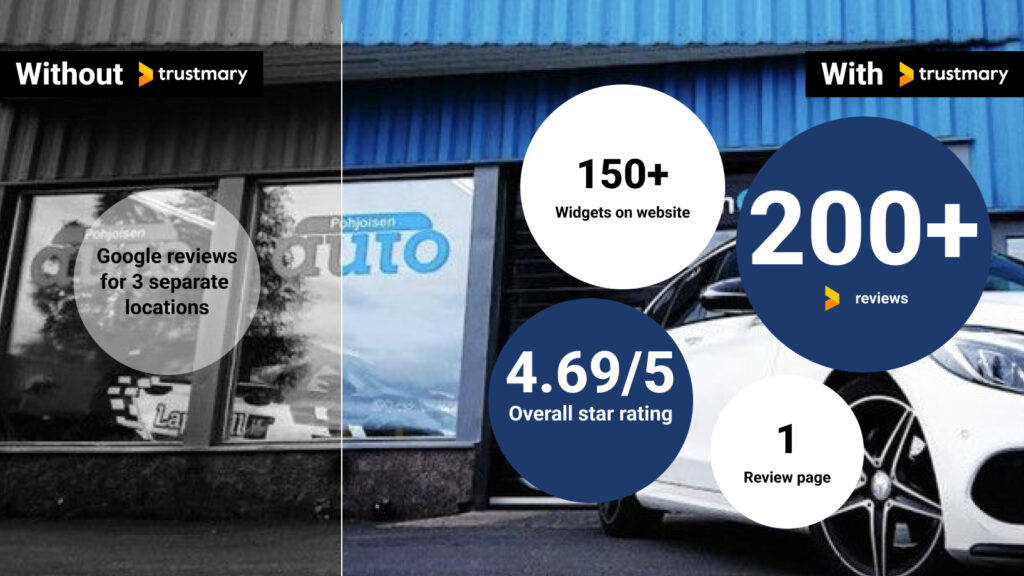
Read the full case on how to get more sales with social proof.
Customer Experience Metrics Explained
A customer health score represents how well an account has adopted your product or service. It is a combination of product usage metrics and customer satisfaction metrics.
The customers who are i
Net Promoter Score (NPS)
Net Promoter Score NPS stands for Net Promoter Score, and it tells you if your customers will recommend your website, brand, service, or product to their friends and family members.
It’s very easy to set up, and the information it provides can help you improve your offer and attract more customers.
What does Net Promoter Score tell me?
NPS tells you if your customers are likely to recommend your offer to other people directly. You can ask your customers if they would recommend you by setting up a simple 1 to 10 rating. If your customers are voting lower than you expected, you can ask them for more details through emails and online surveys.
NPS surveys can also help you to remind your customers to promote your products and services to their friends. Since this simple rating system won’t tell you exactly what your customers think, you will at least get a better insight into how they view your website.
How do I use it?
Include a simple 1 to 10 rating at the end of the checkout process asking your customers whether or not they will be willing to recommend your offer to other people.
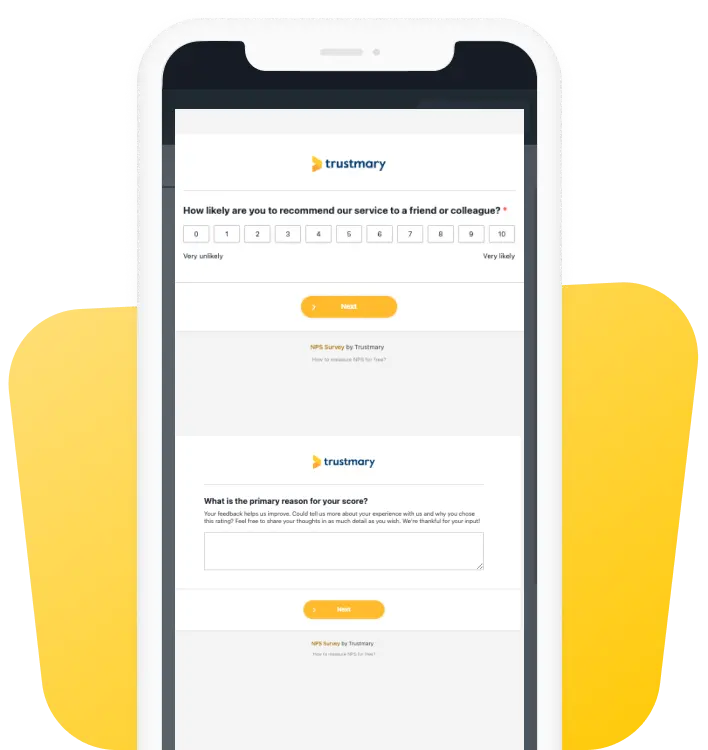
There are three general categories of vote scores:
NPS Promoters - People who leave a 9 or a 10 are most likely to recommend your offer to others.
NPS Passives - Those who score your site with a 7 or an 8 are satisfied with the offer, but they wouldn’t recommend it to friends and family members. Most of these people are not regular customers and would switch to another company with a better offer.
Detractors - People who vote with a 6 or below simply don’t like your brand and wouldn’t recommend it to others. In fact, they will probably tell people not to buy what you are selling.
Use NPS to predict customer churn. Unhappy customers are more likely to leave you than happy customers.
Customer Satisfaction CSAT
Customer satisfaction reflects how happy customers are with a product, service, or experience. It's typically measured through surveys and ratings, helping businesses understand strengths and areas for improvement to enhance retention.
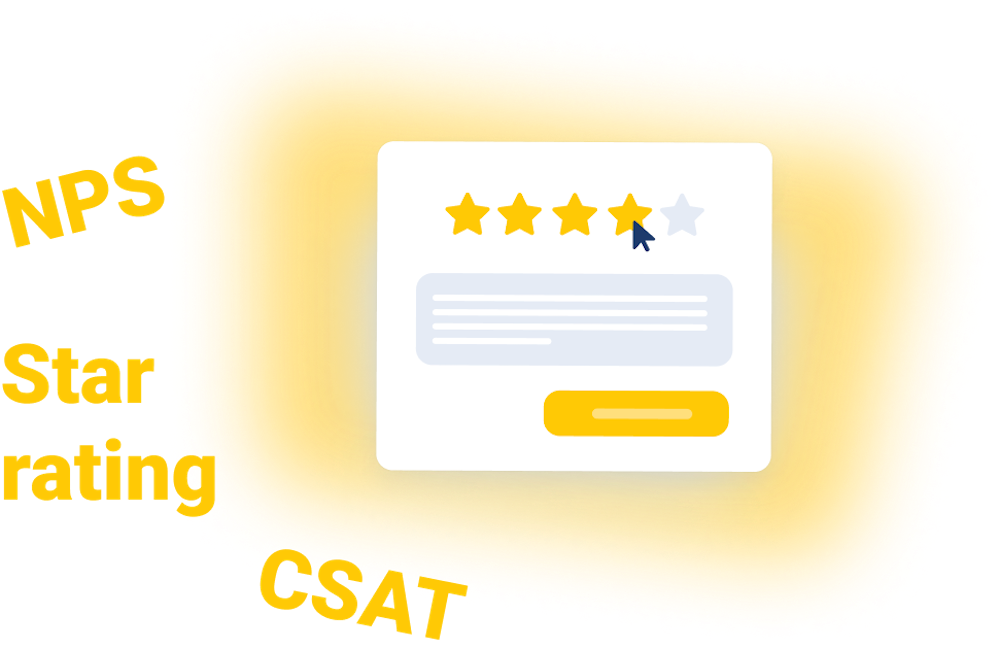
CSAT is a customer satisfaction metric that tells you your overall customer satisfaction. The answers you get are very straightforward and straightforward to set up. The only thing you should keep in mind that these stats won’t be pinpoint precise.
What does CSAT tell me?
CSAT surveys can tell you if your customers are generally satisfied with your offer and website. The problem is that you won’t get accurate details on what impacted their final rating. You can find out if they are satisfied or not, but you won’t know why they voted as they did.
How to use CSAT surveys?
You can set up a simple 1 to 5 rating system about the overall customer experience. The results will tell you if your customers appreciate your offer or if they think that it’s not that great. If you run an international website, you can use emojis or star ratings to make sure that everyone can rate your offer.
You can set up CSAT software for maximum results.
Average Resolution Time
This metric tracks how long it takes for customer issues to be resolved. A lower resolution time indicates efficient support, leading to better customer experiences and improved satisfaction.
Use AI with caution if you operate a live chat. It may frustrate clients, as they can't get their questions answered, even though the average resolution time metrics might seem good.
Customer Effort Score CES
CES stands for Customer Effort Score, and it’s a method that allows you to see how much effort your customers have to make to do what they want.
In other words, it tells you whether or not your website and offers are organised in a way that makes it easy for customers to complete a transaction or a purchase.
Or to interact with you or your staff.
What does Customer Effort Score tell me?
Most CES methods require the use of a short questionnaire. Instead of rating your website or the user experience directly, your customers answer rate your offers with statements such as “Finding what I wanted was very easy” or “The customer service helped me make the right choice.”
Customers value a direct approach more than an over-the-top design that might make finding what they need more complicated.
Most users are far more likely to remember a smooth experience that turned out to be easier to complete than what was expected. Having a beautiful website with tons of options may give you that wow factor, but if finding what they need takes too long for your customers, you will lose many of them before they make a purchase.
The key is to enable your customers to make a purchase as easily as possible. That way, they can come to your website, make a purchase in seconds, and everyone is happy. CES can help you identify the areas that can be made simpler to improve navigation and conversion rates.
How do I use CES to Improve Customer Satisfaction Process?
There are a few different methods you can use to collect customer satisfaction metrics. Here’s a quick overview of the most popular methods and the benefits they provide.
- Email surveys - You can send out surveys to your customer’s email addresses to gain valuable information. Emails provide you with the means to ask everything you need, but they have a low response rate. If you opt for this option, you can use survey tools to set up the perfect survey for your needs.
- Live chat rating - is also a useful method for finding out what your customers think about your website. The best thing about this method is that your customers can simply rate your platform after a customer contacts your support team. This method is useful only for rating the support team, as you won’t be able to get more details on other website features.
- In-app surveys - If you have your own app, you can include a few pop-ups to see what your customers think about it. Ask accurate single customer feedback questions about the features you’re not sure of, and your customers will provide you with useful information.
- Social Media - Is by far the most powerful method of getting to know your customer’s needs. All popular social media will give you access to user reviews and comments that can tell you more about your offer than any survey. Address all negative comments as soon as possible, and your customers will appreciate that.
Customer Sentiment
Customer sentiment analysis evaluates emotions behind customer feedback, reviews, and interactions.
It helps businesses understand whether customers feel positive, neutral, or negative about their brand and make necessary improvements.
Why Customer Sentiment Matters
Unlike structured survey scores, sentiment gives you a qualitative layer of understanding. Are your customers excited? Frustrated? Disappointed? These emotional signals often show up before a customer formally complains or churns.
How to Measure It
Customer sentiment can be assessed through natural language processing (NLP) tools, text analysis software, or manual tagging. Platforms like Trustmary help you analyze trends across open-ended feedback and reviews to determine overall sentiment over time.
Use Sentiment to Drive Change:
- Flag negative trends early and address pain points
- Identify promoters who could provide testimonials
- Understand what delights or annoys customers in their own words
- Tailor marketing and communication strategies to match mood and expectations
By pairing customer sentiment with numerical metrics like CSAT and NPS, you get a full picture of both what your customers experience and how it makes them feel.
Customer Referral Rate
This measures how often existing customers refer new customers to a business.
A high referral rate usually indicates strong customer satisfaction and trust, making it a valuable metric for organic growth.
You should also pay attention to your review rate. That measures how many people are willing to leave a review or a testimonial after leaving open feedback.
Trustmary's users typically have a 32% review rate.
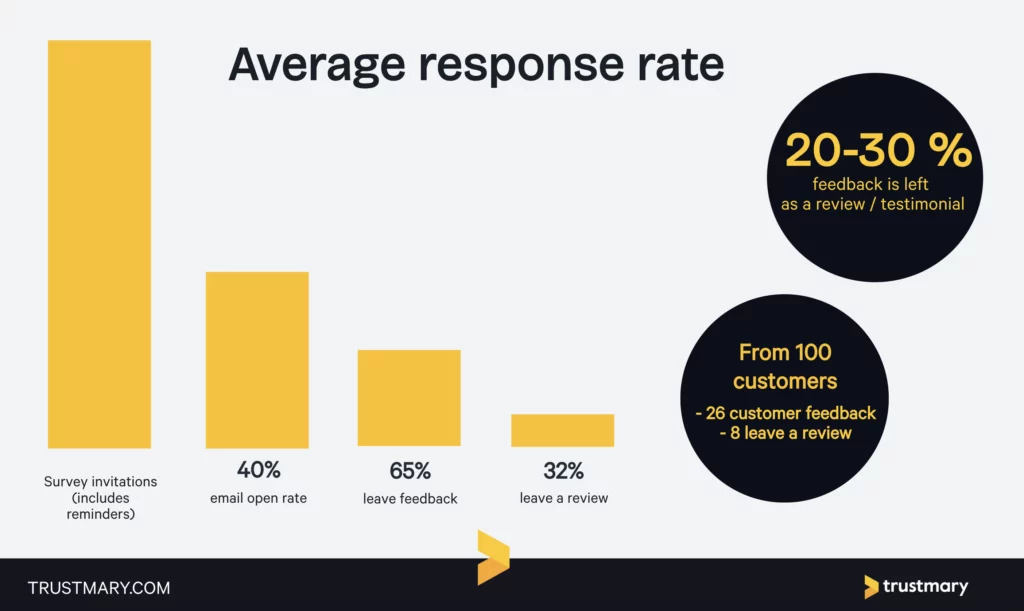
Overall State of Customer Voice
Customer voice includes all feedback channels like online reviews, surveys, social media discussions, and support tickets.
Analyzing this data helps businesses understand customer needs, pain points, and trends to enhance overall experience.
Here's an example of how our customer voice analysis looks. The analysis includes all our third-party reviews, testimonials, and private open feedback.

Customer Acquisition Cost (CAC)
CAC represents the cost of gaining a new customer, factoring in marketing, sales, and other expenses. Keeping CAC low while maintaining quality leads is key to sustainable business growth.
Remember that bucket reference that I made before?
If your bucket is broken, your CAC will be higher and higher over time. By fixing the bucket (=customer experience), your customers are more likely to buy from you again.
This lowers the CAC in the long run.
Customer Churn Rates
Churn rate measures the percentage of customers who stop using a service over a given period.
A high churn rate signals dissatisfaction and retention issues, making it crucial to address underlying problems.
To fight churn, you need to know what your customers feel and think. To be able to fix what's broken, you need to know what's broken first.
Knowing your customer satisfaction levels is the first step to customer churn prevention.
Customer Lifetime Value (CLV)
CLV estimates the total revenue a business can expect from a single customer over their entire relationship.
Why CLV Matters
Being the CEO of a SaaS company, I've learned to put a lot of emphasis on increasing the customer lifetime value of each account.
The longer a customer stays with a company, the more value they bring—not just through repeat purchases but also by referring others and contributing to a positive brand reputation. Focusing on CLV shifts your mindset from chasing one-time transactions to building lasting relationships.
How Customer Satisfaction Affects CLV
Satisfied customers stay longer, spend more, and are more likely to become brand advocates. By improving touchpoints across the customer journey using tools like NPS, CSAT, and CES, you can directly influence CLV.
Ways to Increase CLV:
- Strengthen onboarding to ensure early satisfaction
- Provide exceptional customer service to encourage loyalty
- Use feedback to personalize experiences and offers
- Identify churn risks early through sentiment analysis
A high CLV means lower acquisition costs over time, improved forecasting, and a stronger, more resilient business.
Challenges with Customer Satisfaction Metrics
While customer satisfaction metrics offer invaluable insights, they also come with challenges that can lead to misinterpretation or inaction if not addressed properly.
- Lack of Context: A high CSAT score doesn’t always mean the customer is truly satisfied overall—it might just reflect a single, recent interaction.
- Survey Fatigue: Bombarding customers with too many surveys can reduce response rates and skew results due to frustrated participants.
- Delayed Feedback Loops: Metrics like NPS are often collected too late to make timely improvements in customer experience. (Integrate measuring NPS as a part of your processes to avoid this!)
- Data Silos: When feedback lives in separate systems (CRM, support, marketing), it’s hard to get a holistic view of customer satisfaction. The worst-case scenario is that different teams don't have access to important data, because they're either unaware that the data exists or don't have the needed access to the right systems.
- Actionability: Gathering the data is one thing, but translating it into meaningful improvements requires strategy, ownership, and follow-through.
Being aware of these pitfalls and proactively addressing them ensures that your customer satisfaction metrics don’t just look good on paper—they lead to real improvements.
Try Customer Satisfaction Metric Tools
Customer satisfaction metrics provide a powerful lens through which you can evaluate and enhance every part of your customer journey. They shine a light on what’s working, where friction exists, and how your customers truly feel about your product or service.
But gathering feedback is just the beginning.
To drive real change, you need to act on the insights you collect.
Use these metrics to inform strategic decisions, optimize internal processes, and create customer experiences that keep people coming back—and telling others. Whether it's reducing churn, improving your customer support, or strengthening brand loyalty, measuring and responding to satisfaction data is one of the smartest moves any business can make.
Start small if you must. But start.
And if you want help, Trustmary is here to make collecting, analyzing, and showcasing customer satisfaction easier than ever.
FAQ
What is a good customer satisfaction score (CSAT)?
A CSAT score of 80% or higher is generally considered strong. However, benchmarks can vary by industry.
It's more important to benchmark your CSAT against your history data than against others in your industry. That way, you can identify trends.
How often should I send customer satisfaction surveys?
Only when they make sense. Send them after key interactions—support resolutions, purchases, onboarding. Avoid over-surveying to reduce fatigue.
What’s the difference between CSAT, NPS, and CES?
CSAT measures satisfaction with a specific interaction, NPS gauges loyalty, and CES evaluates how easy it was for the customer to complete a task.
How do I use NPS to reduce churn?
Follow up with detractors to understand pain points. Addressing their concerns can turn them into loyal customers.
Can I automate my customer satisfaction surveys?
Yes! Trustmary allows you to set up automated surveys at different touchpoints, helping you gather continuous feedback without manual work.
